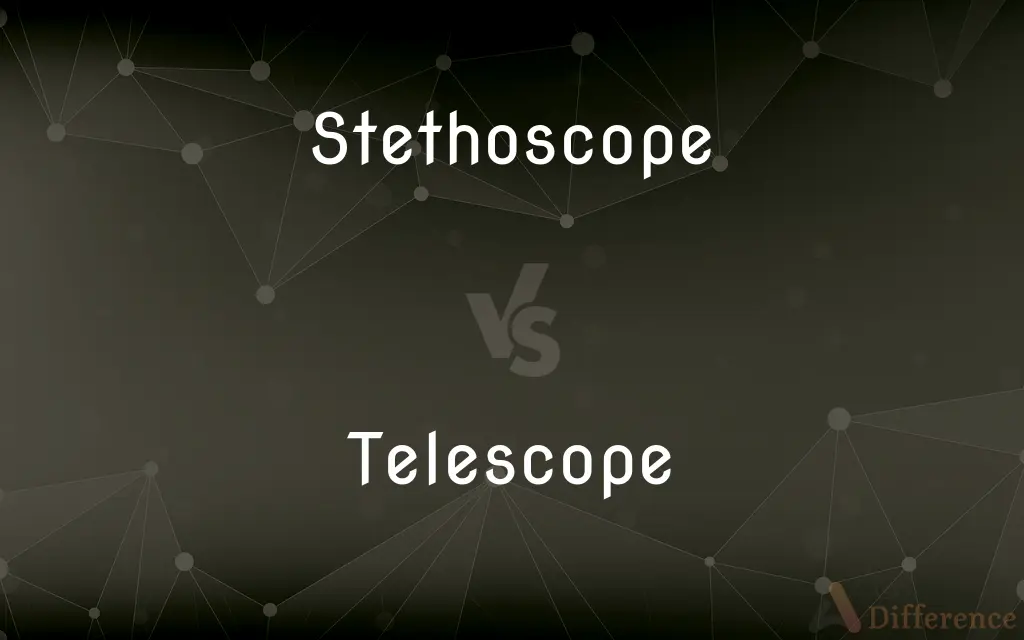Stethoscope vs. Telescope — What's the Difference?
Edited by Tayyaba Rehman — By Fiza Rafique — Updated on April 1, 2024
A stethoscope is a medical instrument used for auscultation, primarily to listen to the heart and lungs, while a telescope is an optical instrument designed to observe distant objects, like stars and planets.

Difference Between Stethoscope and Telescope
Table of Contents
ADVERTISEMENT
Key Differences
A stethoscope is an essential tool in the medical field, designed to amplify internal sounds made by the body, such as heartbeats and lung sounds. It allows healthcare professionals to diagnose various conditions. On the other hand, a telescope is an optical instrument used primarily in astronomy to magnify and observe distant objects in the universe, including stars, planets, and galaxies, facilitating the study of celestial phenomena and the universe's structure.
The design of a stethoscope includes earpieces, tubing, and a chest piece with a diaphragm and/or bell, optimizing it for picking up sound frequencies produced by the human body. A telescope, however, comprises lenses or mirrors, along with an eyepiece, designed to collect and focus light from distant objects, making them appear closer and more detailed to the observer.
Stethoscopes operate on the principle of acoustic resonance, capturing sound waves from the body and transmitting them to the listener's ears. Telescopes work on principles of optics, such as reflection or refraction, to gather and magnify light, enabling the detailed observation of objects that are far away in space.
The use of a stethoscope is primarily confined to the medical and healthcare industry, serving as a fundamental diagnostic tool for doctors, nurses, and other healthcare providers. In contrast, telescopes have a broader range of users, including professional astronomers, amateur stargazers, and educational institutions, highlighting their role in both scientific research and recreational observation.
Despite their different applications, both stethoscopes and telescopes share the common purpose of extending human perception beyond its natural limits stethoscopes enhancing our ability to hear internal bodily sounds and telescopes expanding our visual reach into the distant cosmos.
ADVERTISEMENT
Comparison Chart
Primary Use
Listening to internal bodily sounds for medical diagnosis.
Observing distant celestial objects.
Operating Principle
Acoustic resonance to amplify body sounds.
Optics (reflection or refraction) to magnify light from distant objects.
Main Components
Earpieces, tubing, chest piece with a diaphragm and/or bell.
Lenses or mirrors, eyepiece, mount.
Field of Application
Medicine and healthcare.
Astronomy, both professional and amateur.
Purpose
Diagnose health conditions by auscultation.
Study celestial phenomena and the universe.
Compare with Definitions
Stethoscope
A medical device for listening to the internal sounds of an animal or human body.
The doctor used a stethoscope to check for respiratory issues.
Telescope
An optical instrument for viewing distant objects.
Through the telescope. the rings of Saturn were visible.
Stethoscope
Features a chest piece for sound detection.
The stethoscope's diaphragm enhances the sound of heartbeats.
Telescope
Used in astronomy to explore the universe.
Astronomers use telescopes to study distant galaxies.
Stethoscope
Used by healthcare professionals to diagnose conditions.
Nurses often carry a stethoscope around their neck.
Telescope
Available for both professional and amateur use.
Amateur stargazers often start with a small telescope.
Stethoscope
Relies on acoustic principles.
Stethoscopes transmit body sounds to the examiner's ears.
Telescope
Enhances our understanding of space.
Telescopes have been crucial in discovering new planets.
Stethoscope
Vital for physical examinations.
A physical check-up is incomplete without a stethoscope.
Telescope
Can be refracting or reflecting. based on its lens or mirror system.
Galileo used a refracting telescope to observe the moons of Jupiter.
Stethoscope
The stethoscope is an acoustic medical device for auscultation, or listening to internal sounds of an animal or human body. It typically has a small disc-shaped resonator that is placed against the skin, and one or two tubes connected to two earpieces.
Telescope
A telescope is an optical instrument using lenses, curved mirrors, or a combination of both to observe distant objects, or various devices used to observe distant objects by their emission, absorption, or reflection of electromagnetic radiation. The first known practical telescopes were refracting telescopes invented in the Netherlands at the beginning of the 17th century, by using glass lenses.
Stethoscope
Any of various instruments used for listening to sounds produced within the body.
Telescope
An arrangement of lenses or mirrors or both that gathers light, permitting direct observation or photographic recording of distant objects.
Stethoscope
(medicine) A medical instrument used for listening to sounds produced within the body.
Telescope
Any of various devices, such as a radio telescope, used to detect and observe distant objects by their emission, absorption, or reflection of electromagnetic radiation.
Stethoscope
(transitive) To auscultate, or examine, with a stethoscope.
Telescope
To cause to slide inward or outward in overlapping sections, as the cylindrical sections of a small hand telescope do.
Stethoscope
An instrument used in auscultation for examining the organs of the chest, as the heart and lungs, by conveying to the ear of the examiner the sounds produced in the thorax.
Telescope
To make more compact or concise; condense.
Stethoscope
To auscultate, or examine, with a stethoscope.
Telescope
To slide inward or outward in or as if in overlapping cylindrical sections
A camp bucket that telescopes into a disk.
Stethoscope
A medical instrument for listening to the sounds generated inside the body
Telescope
A monocular optical instrument that magnifies distant objects, especially in astronomy.
Telescope
Any instrument used in astronomy for observing distant objects (such as a radio telescope).
Telescope
(television) A retractable tubular support for lights.
Telescope
(ambitransitive) To extend or contract in the manner of a telescope.
Telescope
(ambitransitive) To slide or pass one within another, after the manner of the sections of a small telescope or spyglass.
Telescope
(intransitive) To come into collision, as railway cars, in such a manner that one runs into another.
Telescope
To collapse, via cancellation.
Telescope
An optical instrument used in viewing distant objects, as the heavenly bodies.
Telescope
To slide or pass one within another, after the manner of the sections of a small telescope or spyglass; to come into collision, as railway cars, in such a manner that one runs into another; to become compressed in the manner of a telescope, due to a collision or other force.
Telescope
To cause to come into collision, so as to telescope.
Telescope
To shorten or abridge significantly; as, to telescope a whole semester's lectures into one week.
Telescope
Capable of being extended or compacted, like a telescope, by the sliding of joints or parts one within the other; telescopic; as, a telescope bag; telescope table, etc.; - now more commonly replaced by the term telescoping.
Telescope
A magnifier of images of distant objects
Telescope
Crush together or collapse;
In the accident, the cars telescoped
My hiking sticks telescope and can be put into the backpack
Telescope
Make smaller or shorter;
The novel was telescoped into a short play
Common Curiosities
Can a telescope be used for purposes other than astronomy?
Yes, telescopes can also be used for terrestrial observation, such as bird watching, though their primary purpose is astronomical.
How does a stethoscope work?
It works by capturing sound waves from the body and transmitting them through the tubing to the earpieces.
Can anyone use a telescope effectively?
With basic knowledge and practice, anyone can use a telescope to observe celestial objects, though advanced observations require more expertise.
What are the main types of telescopes?
The main types are refracting telescopes, which use lenses, and reflecting telescopes, which use mirrors.
What celestial objects can be observed with a basic telescope?
Planets, the Moon, some galaxies, and nebulas can be observed with a basic telescope.
What distinguishes a stethoscope from a telescope?
A stethoscope is used for listening to internal body sounds, while a telescope is for observing distant celestial objects.
Why is a stethoscope important in medicine?
It allows healthcare professionals to detect abnormalities in heart and lung functions that may not be noticeable otherwise.
How has telescope technology evolved?
Telescope technology has evolved from simple optical designs to complex systems using mirrors, lenses, and electronics for enhanced space observation.
Can the use of a stethoscope be learned by anyone?
Yes, with proper training, anyone can learn to use a stethoscope for basic auscultation, though accurate interpretation of sounds typically requires medical expertise.
What advancements have been made in stethoscope design?
Recent advancements include electronic stethoscopes that amplify sounds and can digitally record them.
What materials are used in making stethoscopes?
They are typically made from metal for the chest piece and flexible plastic or rubber for the tubing.
What's the difference between amateur and professional telescopes?
Professional telescopes are larger, more complex, and offer higher precision, while amateur telescopes are more user-friendly and affordable.
Are stethoscopes used for any purposes outside of healthcare?
Primarily, stethoscopes are used in healthcare, though they may have niche applications in fields like acoustical engineering.
How do environmental factors affect stethoscope usage?
Noise and temperature can affect the quality of sound transmission in a stethoscope, impacting its effectiveness.
How do digital telescopes differ from traditional ones?
Digital telescopes use electronic sensors to capture images and often include computer interfaces for data analysis and tracking.
Share Your Discovery

Previous Comparison
Dreary vs. Weary
Next Comparison
Nutrition vs. DigestionAuthor Spotlight
Written by
Fiza RafiqueFiza Rafique is a skilled content writer at AskDifference.com, where she meticulously refines and enhances written pieces. Drawing from her vast editorial expertise, Fiza ensures clarity, accuracy, and precision in every article. Passionate about language, she continually seeks to elevate the quality of content for readers worldwide.
Edited by
Tayyaba RehmanTayyaba Rehman is a distinguished writer, currently serving as a primary contributor to askdifference.com. As a researcher in semantics and etymology, Tayyaba's passion for the complexity of languages and their distinctions has found a perfect home on the platform. Tayyaba delves into the intricacies of language, distinguishing between commonly confused words and phrases, thereby providing clarity for readers worldwide.
















































